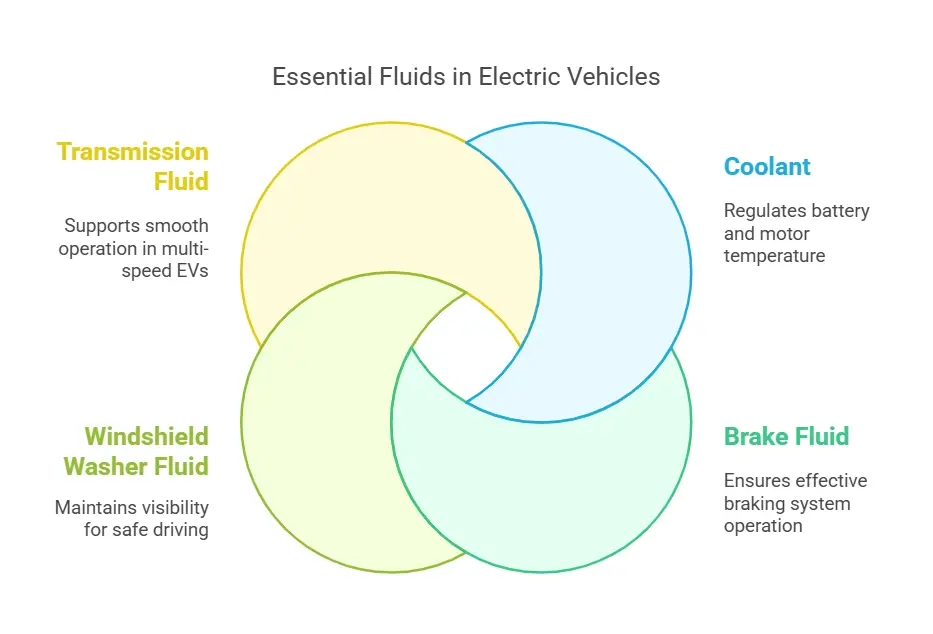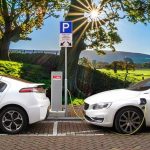Last Updated on January 26, 2025 by
Yes, electric vehicles (EVs) need coolant. While they don’t have a traditional engine, EVs use coolant to regulate the temperature of their battery packs, electric motors, and power electronics. This coolant helps maintain optimal operating temperatures, ensuring efficient performance, longevity, and safety of the EV’s critical components.

That is why electric vehicles are a good possible replacement option for existing automobile generation.
Though EVs use lithium-ion batteries, heat generation happens like it happens in combustion engine vehicles. Consequently, a coolant is a requirement for EVs.
Key Takeaways – Electric Vehicle Coolants and Fluids
Key takeaways about electric vehicle fluids and cooling:
- Essential Fluids
- Battery coolant is critical for temperature regulation
- Brake fluid remains necessary, despite regenerative braking
- Specialized transmission and thermal management fluids are used
- Windshield washer fluid is standard
- Cooling System Characteristics
- EVs use liquid cooling or air cooling technologies
- Coolant circulates through battery pack, motors, and electronics
- Electric water pumps manage cooling efficiently
- Radiators help dissipate heat from critical components
- Unique Fluid Requirements
- EV fluids are specially formulated for:
- Higher temperature tolerance
- Lower electrical conductivity
- Enhanced thermal stability
- Corrosion protection
- Maintenance Differences
- Less frequent fluid changes compared to traditional vehicles
- Most coolant systems are designed to last the vehicle’s lifetime
- Specialized brake fluids and transmission fluids with extended service intervals
What is the coolant used in electric vehicles?
The cooling system of electric vehicles (EVs) is completely different from the cooling system of internal combustion vehicles. The cooling system of an electric vehicle is cooling the battery pack temperature along with the electronics in the system.
There are several methods to cool down the batteries coupled with electronics of an electric vehicle such as using a coolant or air conditioning system or using a refrigerant. Different companies are using different methods.
Majority of the electric vehicles use a system called cooling loop. The loop in most cases contains ethylene glycol but can also use water or refrigerant coolant which circulates within the loop using an electric pump.

Ethylene glycol gets circulated in the loop and goes through the pack of batteries and other electronics in the loop. The loop has a radiator which allows the heat release in to the outside air.
The flow rate of the cooling liquid and the temperature in particular vary. The flow rate of the coolant for electric vehicles at low temperature is roughly 500 L/h and the rate for combustion engine vehicles at high temperature is 5000 L/h.
In most electric vehicles the coolant should last for a lifetime and does not require refills. However, if the coolant level goes down then your car indicators will let you know the same.
So, do electric vehicles need coolant? Yes, they do!
Future Developments for EV Batteries
Key Emerging Technologies
- Thermal Management Innovations
- Advanced liquid cooling systems
- Nanomaterial-enhanced coolant technologies
- Intelligent temperature regulation algorithms
- Battery Performance Improvements
- Reduced degradation rates
- Extended battery lifespan (potentially beyond 20 years)
- Enhanced thermal stability
- Cooling System Advancements
- More efficient electric water pumps
- Precision temperature control
- Reduced energy consumption during cooling processes
Projected Developments
- Coolant flow rates potentially optimized below current 500 L/h
- Lower electrical conductivity in cooling fluids
- Integration of AI for predictive thermal management
- Development of specialized cooling formulations for direct battery cooling systems
Potential Impact: These developments aim to improve EV battery longevity, performance, and energy efficiency, addressing current limitations in electric vehicle technology.Manufacturers are focusing on creating more sophisticated thermal management systems that can maintain optimal battery temperatures with minimal energy expenditure.
What fluids do electric cars need?
Traditional internal combustion engine vehicles require lubrication to wax the pistons, valves and other related moving parts to function smoothly past each other at high speeds. To ensure that all the mechanical parts of the engine runs smooth at all times you need to ensure lubricant checking and re-filling regularly.
| Fluid Type | Specifications |
|---|---|
| Battery Coolant |
• Typically glycol-based • Low electrical conductivity • High thermal efficiency • Temperature range: 20-40°C (68-104°F) • May require special formulations for direct cooling systems |
| Brake Fluid |
• High boiling point (dry and wet) • Low viscosity • Lower conductivity • Often meets DOT 5.1, DOT 4LV, DOT 4, and DOT 3 specifications |
| Transmission Fluid |
• Synthetic formulation • High oxidation and thermal stability • Excellent frictional performance • Immediate lubrication after cold start • Extended drain intervals |
| Driveline Fluid |
• High load capacity • High-temperature stability • Compatibility with copper and insulating materials • Enhanced thermal properties for heat transfer |
| Windshield Washer Fluid | • Standard formulation (no special EV requirements) |
When it comes to electric vehicle’s lubrication is not needed. Electric vehicle requires a pack of batteries to work the electric motor which helps run the car.
The electric motor in an EV is sealed along with the required lubrication. The same may be changed as guided by the manufacturer maintenance chart or earlier in the even there is a functionality problem.
The electric vehicle requires following fluids and routine checkups on them:
- Coolant: All electric vehicles require coolant to flow through the thermoregulation loop system to prevent overheating of the batteries and other electronics. You may need to change or add coolant during your regular maintenance cycle.
- Windshield Cleaning Fluid: Based on your use, the windshield cleaning fluid needs checking and refilling.
- Brake Fluid: Electric vehicles have regenerative braking system which relies heavily on the brake fluid to function smoothly. As a general thumb rule, the brake fluid in the EVs need changing every 25,000 miles or 45,000 Kilometers.
Do electric cars have brake fluid?
Yes, electric cars do have brake fluid. Despite using regenerative braking, EVs still require hydraulic brakes and brake fluid. However, they need specialized brake fluids like DOT 5.1 EV, which offer better corrosion protection, higher boiling points, lower electrical conductivity, and lower viscosity to meet the unique demands of electric vehicles.
Electric vehicles use a regenerative braking mechanism. In regenerative braking the kinetic energy generated when the brakes are on to slow down the car is captured and used to charge your electric vehicle batteries.
In the internal combustion engine vehicles the kinetic energy generated when brakes are on is wasted. The vehicle slows down due to the friction between the rotors and the brake pads and the majority of kinetic energy generated wastes as heat.
The regenerative braking system recaptures almost 70% of the kinetic energy that is generated when brakes are applied. The amount recovered varies from manufacturer to manufacturer of electric vehicles.
Regenerative braking system provides a lot of force to stop the vehicle on its own, but electric vehicles also use conventional hydraulic brakes. Since the majority of braking occurs by the regenerative system the rotors and brake pads have lesser wear and tear.
In electric or internal combustion engine vehicle the purpose of brakes is to slow down the car and during that process of braking kinetic energy is generated due to friction. In both the cases brake fluid is required for smooth braking and to ensure longevity of the rotors and brake pads.
Compare Fluid Change and Maintenance Costs – EV vs ICE vehicles
| Expense Category | ICE Vehicle | Electric Vehicle |
|---|---|---|
| Oil Changes | $120-$250 | $0 |
| Transmission Fluid | $100-$250 | $0-$50 |
| Brake Maintenance | $300-$500 | $100-$200 |
| Coolant/Fluid Replacement | $100-$200 | $50-$100 |
| Total Annual Maintenance | $620-$1,200 | $150-$300 |
Do electric cars need lubricants?
Yes, electric cars need lubricants, but different from traditional vehicles. EVs require specialized fluids for their electric motors, batteries, inverters, and transmissions. These EV-specific lubricants are designed to withstand higher temperatures, provide better corrosion protection, and offer enhanced thermal stability and electrical compatibility for optimal performance and longevity of electric vehicle components.
Electric cars use vastly different drive lines, so you don’t have to ever worry about changing the oil during your routine maintenance drill. The internal combustion engine (ICE) cars require oil to ensure that the parts are well waxes as they move between each other.
The ICE car engine uses pistons, valves and other mechanical parts which cause friction as they move inside the engine. To ensure that these parts continue to function at their optimum need for oil in the internal combustion engine arises.
The high speed movement of mechanical parts in the ICE leads to accumulation of atomic metal residue in the oil. You have to change the lubricant from time to time in the ICE powered car.
In case of electric vehicle this is not required, as EV is powered by consuming battery while running an electric motor. The lubricants inside the electric motor are sealed and EVs use drivetrain that is completely different. It does not require frequent or routine change of lubricants.
Do electric cars have water pumps?
Yes, electric cars have water pumps, but they are electric rather than mechanical. Most EVs use multiple electric water pumps to circulate coolant through various components, including the battery pack, electric motors, inverter, and power electronics. These pumps activate only when cooling is needed, improving efficiency and longevity.

Electric cars generate heat and require a cooling system, water pumps help in cooling down the electric cars.
EVs mostly don’t use air cooling technology because it is not efficient and consistent as liquid cooling. There are several variables in the EV (similar to ICE) that require consistent cooling at all times.
There are several parts and components inside an electric vehicle that generate heat, but they do not generate heat equivalent to internal combustion engine vehicle. This leads to designing different cooling systems for EVs.
Do electric vehicles need coolant? Let’s find out more about cooling systems.
All EVs have slight variations in the components that require cooling. However, following are standard in most EVs:
- Electric Motor
- Inverter
- Batteries
- DC converter
In most EVs there are two or three electric water pumps which are part of the EVs cooling system. These come on when the EVs engine and other components require cooling.
Is there a radiator in electric vehicle?
Yes, electric vehicles have radiators, but they serve a different purpose than in traditional cars. EV radiators are part of the cooling system that manages temperatures for the battery pack, electric motors, and power electronics. These components use liquid coolant circulated through radiators to dissipate heat and maintain optimal operating temperatures.
Traditional internal combustion engine (ICE) cars have radiators to help cool down the engine and other related components. The EVs do not have many moving parts and engine like ICE cars and the heat generated in EVs is primarily from the batteries which is used to power up the car.
The heat generated in an EV is due to the batteries. The cooling system that EVs need is called heat exchangers close to their batteries for cooling.
When EV is in motion or getting charged the batteries start to heat, faster the discharge or charge, higher is the heat generated. There are two ways to cool EV batteries and electric motors:
- Air Cooling System: This method is used to cool down the batteries with passive and active airways. Passive cooling takes the outdoor or the cabin air to cool or heat the batteries.
Active cooling uses air from the air conditioner that has evaporator and heater to control the temperature.
- Liquid Cooling: This is a popular way to cool EVs. The cooling liquid runs through the cold plates, tubes and other components surrounding the batteries and takes it to the radiator or heat exchanger.
Electric cars which use liquid cooling to reduce the heat in the batteries and other components of EV use radiators.
FAQ relating to electric vehicle coolant
The most frequently asked questions about electric vehicles is if they need to have a coolant. The answer lies in whether you need liquid cooling for your EV or air blast cooling.
Consequently, it all depends on the category of the EV that you own, as coolants are based on that. To answer the question, do electric vehicles need coolant, the answer has to be “yes”.
Do electric cars use any fluids?
Yes, electric cars use several fluids. These include battery coolant, brake fluid, transmission fluid, thermal management fluid, and windshield washer fluid. Unlike traditional vehicles, EVs require specialized formulations designed for higher temperatures, better electrical compatibility, and enhanced thermal stability. These fluids are crucial for maintaining optimal performance and longevity of EV components.
Do electric cars need oil or coolant?
Electric cars don’t need engine oil, but they do require coolant. EVs use coolant to regulate temperatures of batteries, electric motors, and power electronics. The cooling system circulates coolant through components and radiators to dissipate heat, ensuring optimal performance and longevity of EV parts.
How long do electric car batteries last?
Electric car batteries typically last 15-20 years, with an average degradation rate of about 1.8% per year under moderate conditions. Most manufacturers offer warranties of 8 years or 100,000 miles. With proper care, EV batteries can often outlast the vehicle itself, potentially reaching 200,000 miles or more before needing replacement.
Do electric cars have transmission fluid?
Yes, electric cars have transmission fluid. EVs use specialized fluids for their single-speed transmissions, designed to lubricate, manage temperatures, and protect against corrosion. These fluids withstand higher temperatures and have lower electrical conductivity than traditional transmission fluids. Some EVs may not require regular fluid changes, while others recommend high-mileage inspections.
Here’s the schema markup for the FAQ section in JSON-LD format: “`html “` Citations: [1] https://ppl-ai-file-upload.s3.amazonaws.com/web/direct-files/25547984/e8e08fbd-f5eb-4117-8558-ab7b1444964a/paste.txtDo Evs need cooling?
- Lavender Oil - February 2, 2025
- Electric Cars with Solar Panels On Roof: The Future of Sustainable Driving - January 29, 2025
- Best Cheapest Electric Car Reddit Comments - January 23, 2025








